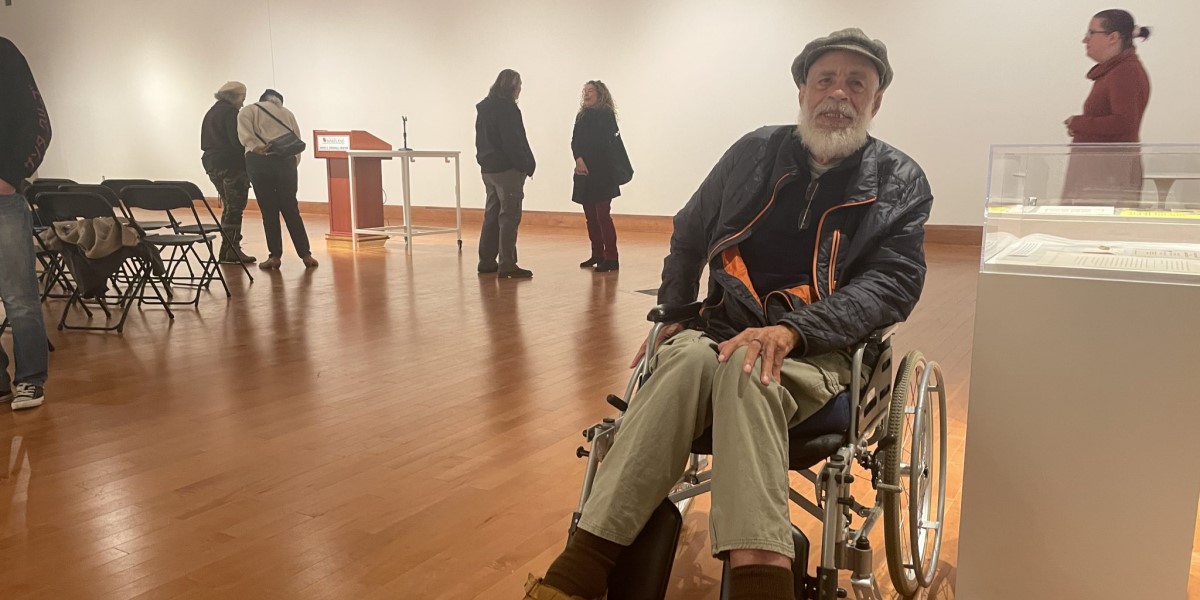MLIS students from the UMD College of Information share the life and work of renowned artist Alonzo Davis

Alonzo Davis poses for a portrait during a student symposium held on Nov. 20, 2023, at the Driskell Center. (Cecilia Clemens Vargas Lugo/The Diamondback)
Students from the University of Maryland’s information studies college shared the life and work of renowned artist Alonzo Davis in a presentation and virtual exhibition at the David C. Driskell Center on Thursday.
The student symposium focused on Davis’ work with public art throughout his career, based on knowledge the students gathered by scouring through digitized archives of Davis’ art and personal documents from the Driskell Center. The presentation came after students spent a semester in a course at this university — called “Arrangement, Description, and Access for Archives” — that taught them how to process archival collections after they have been acquired by an archive.
Eric Hung, an adjunct lecturer in the information studies college who teaches the course on archives, believes the first user and researcher of a collection should be the archive that owns it.
“The collection doesn’t do any good unless you tell people about it. That best way to tell people about it is to produce research about it,” Hung said.
The Driskell Center acquired the collection last year, after assistant archivist Karina Nelson attended a reception of one of Davis’ exhibitions.
Davis took a tour of the Driskell Center and decided to donate his collection, according to Nelson.
“It was a very natural progression, I would say, of him starting to think about what his legacy is going to be and us happening to meet at the right time,” Nelson said.
Since the archives course at this university is asynchronous and online, Nelson, along with other archivists and Driskell Center staff, spent dozens of hours helping digitize and scan the more than 35,000 total items students identified and researched.
For Kate Campbell, a graduate student studying library and information science, archives are important because they make materials accessible to others. Campbell took the archives course and contributed to analyzing Davis’ collection.
“By making them accessible, we’re also opening them up to political engagement, philosophical engagement,” Campbell said.
While the Driskell Center’s archives focus largely on Black artists on the east coast, they also encompass artists from across the nation. Davis produced work around the country with some of his most prominent works coming out of his time in Los Angeles.
During the 1970s and 1980s, Davis was involved in the California mural movement.
Davis and his brother, Dale Davis, also opened the Brockman Gallery in 1967. The gallery was the first major gallery for Black artists in Los Angeles and helped further Black artists’ careers until its closing in 1990.
While some archival collections may focus more on the bigger-picture accomplishments of an artist, this collection provided an in-depth understanding of Davis and his work, according to Benjamin Henry, a graduate student studying library and information science who took the course.
“With archives like this, you really can get deeper and really get to know someone in a much more intimate way,” Henry said.
Davis attended Thursday’s event and said he admires the work of the Driskell Center and was honored to be able to see his collection presented.
“I’m glad to live long enough to see it as a reality … It usually happens after somebody is deceased,” Davis said. “So this is kind of being a living museum in a way.”
The original article by Cecilia Clemens Vargas Lugo was published in the Diamondback on December 3, 2023.